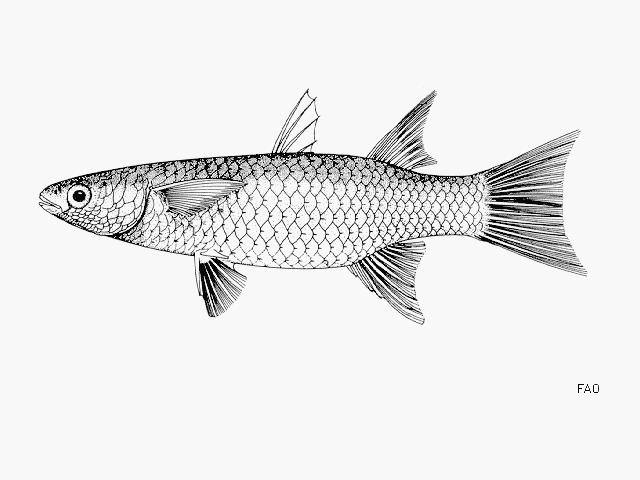| Mugilidae (Mullets) |
| 40 cm TL (male/unsexed) |
|
pelagic-neritic; freshwater; brackish; marine, catadromous |
| Eastern Atlantic: West African coast, from the outlet of the River Senegal (Ref. 57400) to Congo, and on the islands of Bioko (Fernando Poo) and Sao Tome (Ref. 81659). Also reported from Mauritania (Ref. 5377). |
|
Anal soft rays: 8-9. Diagnosis: 8-9 anal soft rays; anal fin and lower lobe of caudal fin yellowish (Ref. 57400). Scales large, 25-30 (usually 27-29) in a longitudinal series (excluding scales on caudal fin base)(Ref. 57400, 81659), 8-10.5 scale rows between pelvic and first dorsal fins (Ref. 81659). Body with ctenoid scales, except for anterior predorsal scales which are cycloid and extend to anterior nostril or slightly beyond; scales usually with only 1 groove (some predorsal scales with 2 or rarely 3 small grooves); posterior end of maxilla sigmoid, curved down over premaxilla; serrate, anteroventral edge of lachrymal distinctly concave; pharyngobranchial organ with 2 valves, anteroventral valve usually a small, finger-like process, sometimes with fringe of smaller processes or papillae positioned ventrally at base, posterodorsal valve usually a small, squarish flap which is fimbriate, terminating in 2-3 short filaments (Ref. 81659).
Description: body rather deep (Ref. 81659), elongate, moderately compressed, reaching its greatest depth at level of anal-fin origin (Ref. 57400). Head broad; interorbital space almost flat (Ref. 57400). Snout blunt (Ref. 81659), long and strongly rounded (length about equal to half of width)(Ref. 57400). No adipose eyelid (Ref. 57400). Upper lip thin and smooth (Ref. 57400). Teeth on both lips either absent or very small, ciliiform, well spaced (Ref. 81659) and in single row or rarely in two rows on upper lip (Ref. 57400, 81659). Hind end of upper jaw reaching a vertical line passing slightly in front of eye margin; maxillary pad visible below corner of mouth when closed (Ref. 57400). Origin of 1st dorsal fin either nearer to caudal-fin base than to snout tip, or equidistant from these two points (Ref. 57400). Second dorsal fin with 9 (rarely 8 or 10) segmented rays; anal fin with 3 spines and 9 segmented rays in adults (1st spine very short and usually hidden by overlying scales), usually 2 spines and 10 segmented rays in juveniles <30 mm SL; anterior rays of second dorsal fin may be elongate, giving somewhat falciform appearance, but not as distinct as in Liza falcipinnis; pectoral fin 81-99% of head length with one short, unsegmented ray dorsally and 13-16 (usually 15) longer, segmented rays (Ref. 81659). Pectoral axillary process absent (Ref. 57400). 5-10 pyloric caeca, which may be bifurcate but not as extensively as in Liza falcipinnis (Ref. 81659). Caudal fin broad (caudal peduncle deep)(Ref. 57400).
Coloration: greyish or brownish olive dorsally; silvery grey on flanks, perhaps with touches of yellow (Ref. 57400, 81659). Opercle darkish; dorsal fins dusky; caudal fin dusky, lower lobe may be yellowish; anal fin variable between pale and dusky, perhaps slightly yellowish at distal margin; pelvic fins pale and may have yellow margin; pectoral fin grey, with dark spot at origin (Ref. 81659). |
| Very common in lagoons and estuaries; an extremely euryhaline species (from 0-66‰), but preferring areas close to the sea in estuaries and lagoons (Ref. 57400), often with muddy substrates (Ref. 81659). Inhabits shallow coastal waters, estuaries and brackish lagoons (Ref. 2683), including mangroves (Ref. 2683, 81659), creeks, estuaries, inundated mudflats (Ref. 81659) and freshwater rivers (Ref. 7399). Oviparous, eggs are pelagic and non-adhesive (Ref. 205). Maximum reported size 297 mm FL, but possibly up to 400 mm (Ref. 57400, 81659). |
|
Data deficient (DD); Date assessed: 01 May 2013 Ref. (130435)
|
| harmless |
Source and more info: www.fishbase.org. For personal, classroom, and other internal use only. Not for publication.

